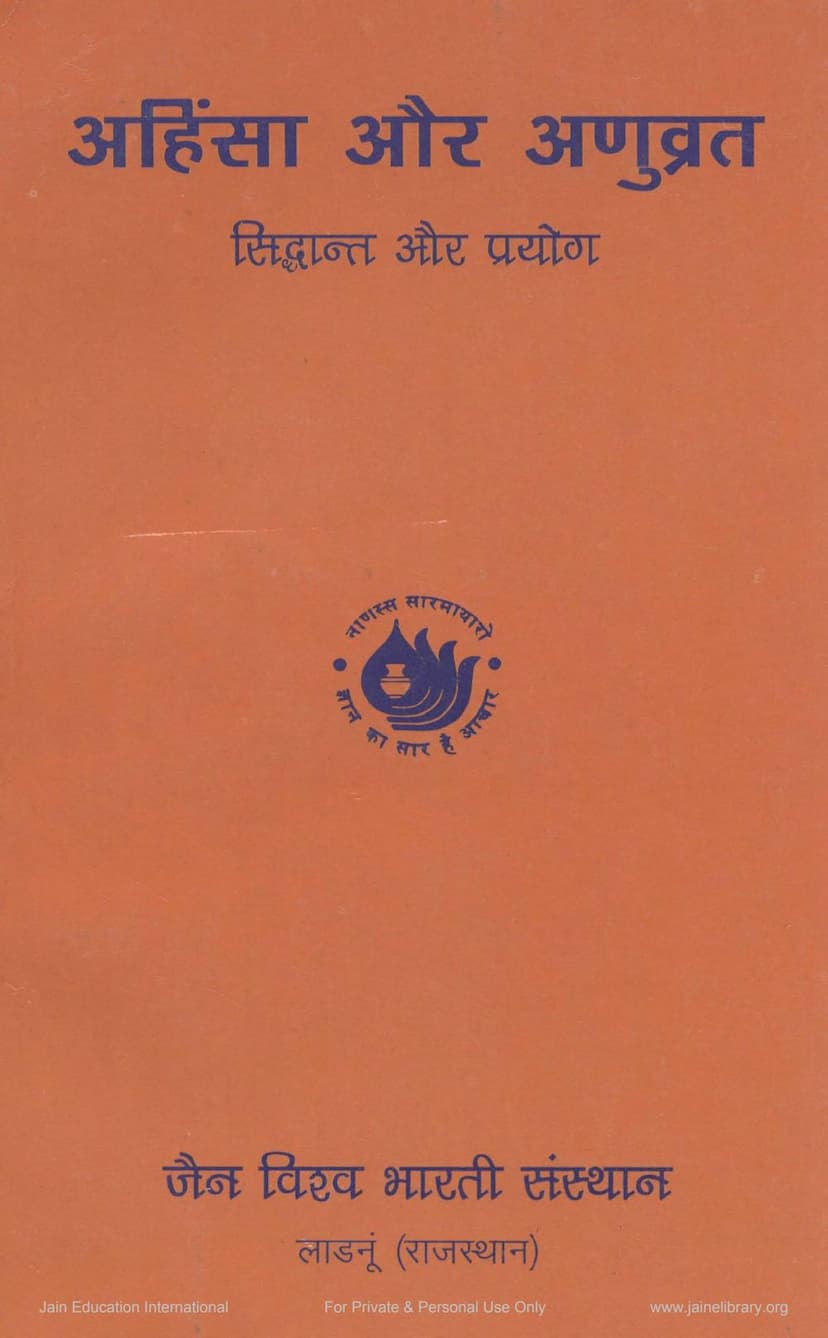Ahimsa Aur Anuvrat
Added to library: September 1, 2025

Summary
The book "Ahimsa aur Anuvrat: Siddhant aur Prayog" (Ahimsa and Anuvrat: Principle and Practice), compiled by Sukhalamuni and Anand Prakash Tripathi, published by Jain Vishva Bharati, is an academic text approved by Ajmer University for its BA curriculum on "Life Science and Jain Vidya". The book, under the guidance of Acharya Tulsi and Acharya Mahapragya, aims to elucidate the principles and practical applications of Ahimsa (non-violence) and Anuvrat (vows of limited practice) within Jainism.
Key Themes and Content:
The book is structured into two main sections: "Principle" (Siddhant) and "Practice" (Prayog).
Part 1: Principle (Siddhant)
This section delves into the theoretical underpinnings of Ahimsa and Anuvrat.
-
Ahimsa (Non-violence):
- Concept and Origin: It explores the fundamental nature of Ahimsa, its roots in Jain philosophy, and its social and spiritual significance. It posits that Ahimsa's scope evolved from a social necessity for peaceful coexistence to a spiritual principle of absolute non-violence for liberation.
- Ahimsa in Indian Philosophy: The text examines the concept of Ahimsa across various Indian philosophical schools, highlighting its central role in Jainism, which defines it in terms of abstaining from violence through mind, speech, and action. It also touches upon the idea of "atmaupamya-drishti" (seeing all beings as oneself) as a core principle of Ahimsa.
- Practical Aspects of Ahimsa: This part discusses how Ahimsa is to be integrated into daily life, including its connection to diet, physical postures (asanas), and the cultivation of an non-violent personality. It also addresses violence related to mental stress, addiction, and the cycle of life and death.
- Ahimsa and Disarmament: The book connects Ahimsa to the contemporary issue of disarmament, arguing that true disarmament begins with emotional and mental restraint, not just physical weapons. It discusses environmental balance and our relationship with the plant kingdom from an Ahimsic perspective.
- Ahimsa and Social Harmony: It explores Ahimsa as the foundation for social coexistence, addressing issues like casteism, linguistic divisions, and the absence of mutual respect, all of which hinder social harmony. Economic life is also examined through the lens of "saapeksha" (relativity) and the avoidance of exploitation. Emotional well-being is linked to Ahimsa, as is the control of the mind and biological rhythms.
-
Anuvrat (Limited Vows):
- Concept of Anuvrat: It explains the nature of Anuvrat as vows taken by lay followers, a modified and practical application of the Mahavratas (great vows) for ascetics. It discusses the reasons for the "Anu" (small/limited) aspect, stemming from the practical capacity of householders.
- Anuvrat Movement: The book traces the origins and philosophy of the Anuvrat movement initiated by Acharya Tulsi, which aimed at moral and character purification transcending social divisions. It highlights its role in awakening social consciousness and fostering ethical behavior.
- Relevance of Anuvrat: It emphasizes that Anuvrat are not merely restrictive but constructive, fostering self-reliance and ethical development. The text discusses the spiritual and social value of practicing these vows and their role in building an Ahimsak society.
Part 2: Practice (Prayog)
This section provides practical guidance and techniques related to the principles discussed.
- Kayotsarga: A Jain practice of self-observation and detachment from the body, aimed at physical and mental relaxation and spiritual awareness.
- Asanas and Pranayama: It details various yogic postures and breathing techniques, explaining their benefits for physical health, mental clarity, emotional balance, and spiritual development. Specific asanas like Shashankasana, Ardha Matsyendrasana, Baddha Padmasana, Yoga Mudra, Paschimottanasana, Gomukhasana, Simhasana, Ushtrasana, and Chakrasana are described with their procedures and benefits.
- Anuprekshas (Reflective Meditations): This section presents guided meditations on virtues like Maitri (friendship), Karuna (compassion), Abhay (fearlessness), Sahishnuta (tolerance), Sankalp Shakti (power of resolve), Attutla (self-balance), and Ahimsa-Anuvrat. Each meditation includes a step-by-step procedure, contemplation points, and guidance on cultivating these qualities.
- Color Meditation: A brief mention of color meditation is included.
Overall Message:
The book strongly advocates for the integration of Ahimsa and ethical principles (Anuvrat) into personal and societal life. It argues that a balanced approach, encompassing both material well-being and spiritual development, is crucial for individual and collective progress. The text emphasizes that true societal harmony and peace can only be achieved through the consistent practice of non-violence, self-control, and mutual respect, rooted in a deep understanding of the interconnectedness of all life. The practical exercises are designed to facilitate the cultivation of these virtues, leading to a more peaceful and ethical existence. The work highlights the need for a shift from superficial adherence to a deeper, experiential understanding and practice of these Jain principles, aligning with modern scientific insights where applicable.